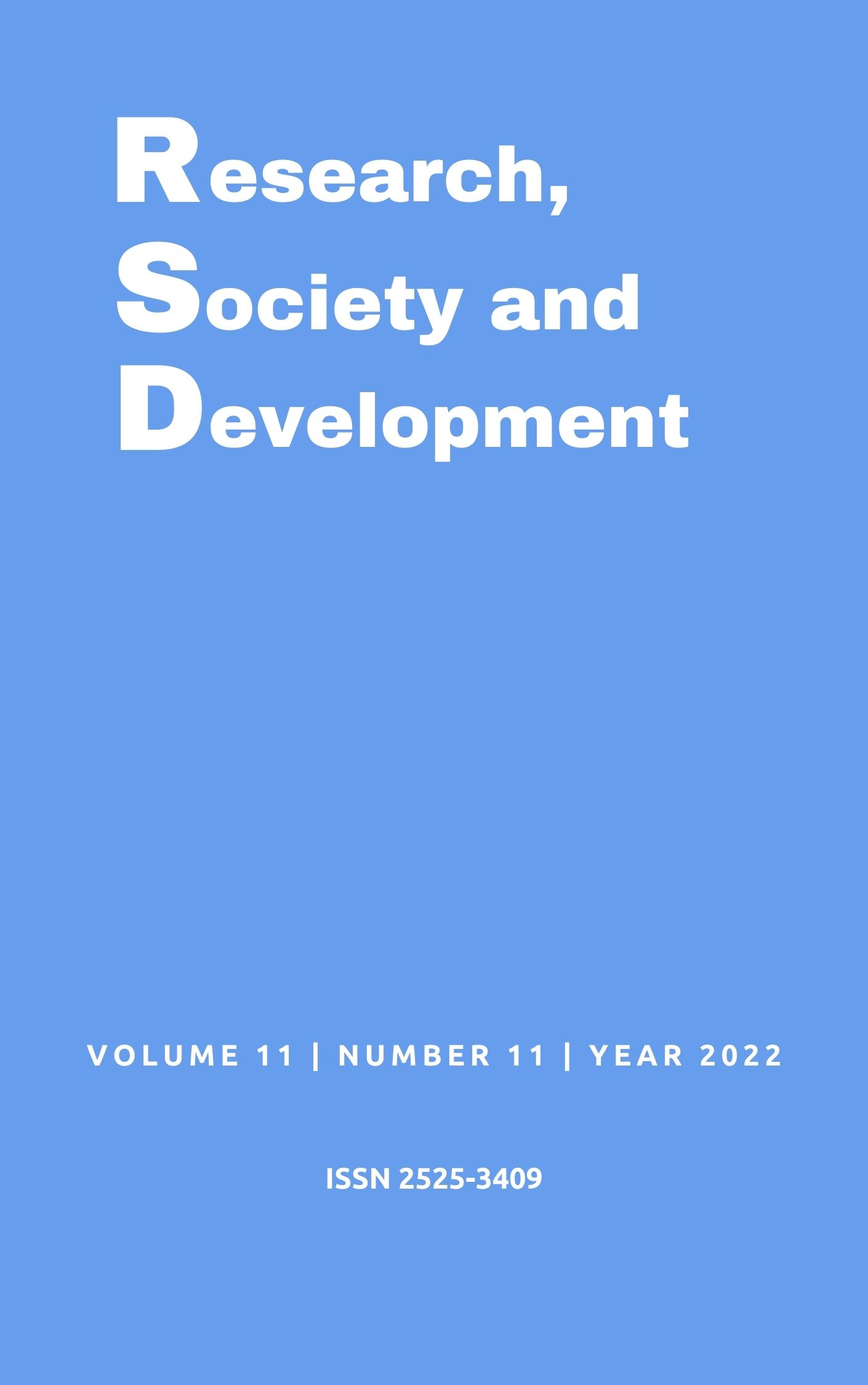Class I treatment with severe dental crowding and mandibular protrusion: a case report
DOI:
https://doi.org/10.33448/rsd-v11i11.33233Keywords:
Orthodontics, Intercurrent orthodontics, Tooth extraction, Supernumerary tooth, Aesthetics.Abstract
The use of Corrective Orthodontics to modifying dental aesthetics, has been increasingly effective in modifying and improving the profile of patients. Objective: Review the literature on the treatment of Cl I malocclusions with severe dental crowding and to report a clinical case performed in the dental clinic of a private educational institution. Methodology: After dental extraction and fixed orthodontic appliance treatment, the facial and dental aesthetics patient evolution with the diastema presence between dental elements 11 and 21 and supernumerary elements. The case was treated in two phases, with the aim of correcting the dental crowding. In the first phase, the first premolars and a supernumerary tooth were extracted, to initiate the isolated canine retraction and, later, the space closures by means of the retraction of the incisors. In the second phase, after the closure of spaces, the intrusion and molarization verticalization phase was started. For the subject review in case, articles were searched in the Pubmed databases, Lilacs and Scielo and selected 8 articles between the years 2010 and 2019.Results and Conclusions: It was observed that the exodontia provided the necessary spaces for the alignment and leveling of the teeth and the intrusion and mandibular rotation of the molars allowed the mandible to rotate counter clockwise, reducing the convex profile of the patient. At the end of the treatment, a facial response was observed according to the mechanics employed and significant improvement in the dental, facial aesthetics and, consequently, social improvement of the patient.
References
Allgayer, S., & Mezomo, M. B. (2018). Do premolar extractions necessarily result in a flat face? No, when properly indicated. Dental press journal of orthodontics, 23(5), 82–92.
Borges, G. S., de B.Santos, J. B. (2022) . Orthodontic treatment in an adult patient to recover lost space after tooth extraction: case report. Research, Society and Development, [S. l.], v. 11, n. 7, p. e53611730443.
Ikoma, M., & Arai, K. (2018). Craniofacial morphology in women with Class I occlusion and severe maxillary anterior crowding. American journal of orthodontics and dentofacial orthopedics: official publication of the American Association of Orthodontists, its constituent societies, and the American Board of Orthodontics, 153(1), 36–45.
James, I. T., Walne, A. J., & Perrett, D. (1996). Automated solid-phase extraction with high-performance liquid chromatography analysis of pyridinium crosslinks. Analytical biochemistry, 240(1), 29–36.
Janson, G., Barros, S. E., de Freitas, M. R., Henriques, J. F., & Pinzan, A. (2007) Class II treatment efficiency in maxillary premolar extraction and nonextraction protocols. American journal of orthodontics and dentofacial orthopedic: official publication of the American Association of Orthodontists, its constituent societies, and the American Board of Orthodontics, 132(4), 490–498.
Jiang, C., Liu, Y., Cheng, Q., He, W., Fang, S., Lan, T., & Wang, J. (2018). Chin remodeling in a patient with bimaxillary protrusion and open bite by using mini-implants for temporary anchorage. American journal of orthodontics and dentofacial orthopedics: official publication of the American Association of Orthodontists, its constituent societies, and the American Board of Orthodontics, 153(3), 436–444.
Jiang, H., Tai, B. J., & Du, M. Q. (2015). Patterns and Risk Factors for White Spot Lesions in Orthodontic Patients
Konstantonis, D., Vasileiou, D., Papageorgiou, S. N., & Eliades, T. (2018). Soft tissue changes following extraction vs. nonextraction orthodontic fixed appliance treatment: a systematic review and meta-analysis. European journal of oral sciences, 126(3), 167–179.
Michelotti, A., & Iodice, G. (2010). The role of orthodontics in temporomandibular disorders. Journal of oral rehabilitation, 37(6), 411–429.
Moresca R. (2014). Class I malocclusion with severe double protrusion treated with first premolars extraction. Dental press journal of orthodontics, 19(3), 127–138.
Naraghi, S., Andrén, A., Kjellberg, H., & Mohlin, B. O. (2006). Relapse tendency after orthodontic correction of upper front teeth retained with a bonded retainer. The Angle orthodontist, 76(4), 570–576.
Picanço, P. R., Valarelli, F. P., Cançado, R. H., de Freitas, K. M., & Picanço, G. V. (2013). Comparison of the changes of alveolar bone thickness in maxillary incisor area in extraction and non-extraction cases: computerized tomography evaluation. Dental press journal of orthodontics, 18(5), 91–98.
Primosch R. E. (1981). Anterior supernumerary teeth--assessment and surgical intervention in children. Pediatric dentistry, 3(2), 204–215.
Rajab L. D. (2002). Clinical performance and survival of space maintainers: evaluation over a period of 5 years. ASDC journal of dentistry for children, 69(2), 156–124.
Sarne, O., Shapira, Y., Blumer, S., Finkelstein, T., Schonberger, S., Bechor, N., & Shpack, N. (2018). Supernumerary Teeth in the Maxillary Anterior Region: The Dilemma of Early Versus Late Surgical Intervention. The Journal of clinical pediatric dentistry, 42(1), 55–61.
Eitelbaum, V., Balon-Perin, A., De Maertelaer, V., Daelemans, P., & Glineur, R. (2002). Impact of dental and skeletal movements on the facial profile within the framework of orthodontic and surgical treatments. The International journal of adult orthodontics and orthognathic surgery, 17(2), 82–88.
Downloads
Published
Issue
Section
License
Copyright (c) 2022 Ranyele Elis Alexandre Rodrigues; Manuela Timbó Farrapo; Samara Tábata Cavalcante Braga Medeiros; Paulo Roberto Barroso Picanço

This work is licensed under a Creative Commons Attribution 4.0 International License.
Authors who publish with this journal agree to the following terms:
1) Authors retain copyright and grant the journal right of first publication with the work simultaneously licensed under a Creative Commons Attribution License that allows others to share the work with an acknowledgement of the work's authorship and initial publication in this journal.
2) Authors are able to enter into separate, additional contractual arrangements for the non-exclusive distribution of the journal's published version of the work (e.g., post it to an institutional repository or publish it in a book), with an acknowledgement of its initial publication in this journal.
3) Authors are permitted and encouraged to post their work online (e.g., in institutional repositories or on their website) prior to and during the submission process, as it can lead to productive exchanges, as well as earlier and greater citation of published work.


